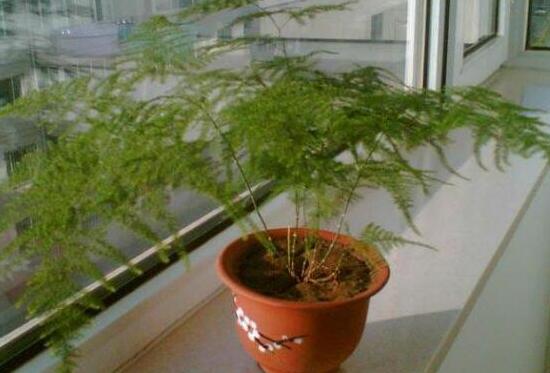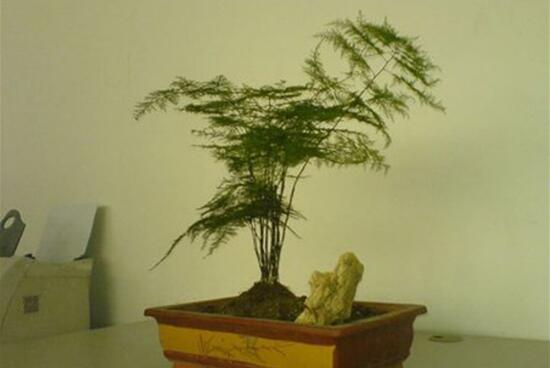How to water the dwarf bamboo, and how often is it watered / not dry or watered thoroughly?
For dwarf asparagus, flower friends should be no stranger, it is cultivated by ordinary asparagus, although relatively short, but the leaves are green, evergreen, better ornamental. However, if you want to appreciate the beauty of dwarf asparagus, careful maintenance is very important, especially watering. So, how do you water it, and how often do you water it? Today, the editor is here to solve this problem for everyone.
First, how to water dwarf asparagus, depending on the temperature

To water the dwarf asparagus, you can't just look at whether it should be watered, but also pay attention to the temperature. Because if the temperature is very high, it will cause the root of dwarf asparagus to rot, but if the temperature is very low, it will also frostbite the plant. So how to water the dwarf asparagus, we must first maintain the growth environment of 10-25 ℃, and then water it according to the pot soil and leaves.
(1) watering principle, watering through
The breeding method of dwarf asparagus is not difficult, but in the simplest watering, many flower lovers are prone to mistakes. This is actually when you watered the dwarf bamboo when it was not short of water, but when it was time to water it, did you water it thoroughly? Watering the dwarf asparagus can not only wet the topsoil of the flowerpot, which will lead to a fundamental lack of water, and it will also cause it to wither over a long period of time.
(2) how often is the dwarf bamboo watered?
With regard to the watering time of asparagus, in fact, it is not fixed, and watering should also be carried out by observing the dry and wet of the basin soil. the specific requirements are as follows:
Whether or not to water the dwarf asparagus, flower friends need to observe the state of the pot soil to decide. If the basin soil is relatively dry or even shows signs of cracking, it should be watered; if the basin soil is wet, do not water it. To put it simply, it can be done in eight words: "if you don't do it, you will water it thoroughly."
Note: when many people water the plants, they will look at the growth status of the leaves and water them when they find that the leaves are shrinking. But this method is not suitable for dwarf asparagus. Once you see the leaves of dwarf asparagus wither, you also water them. It is easy to water too much, and even rot the roots in serious cases.
(3) watering in four seasons
The growing season of dwarf asparagus is in spring and autumn, so we should water it thoroughly at this time and keep it at an interval of once a week. But in summer and winter, when the temperature is too high or too low, dwarf asparagus will enter a dormant period, do not water frequently at this time, so as not to cause damage to the roots of dwarf asparagus. If you feel dry indoors, you can spray some water mist around the leaves of asparagus.
(4) what if the dwarf asparagus is watered too much?
No matter how to water the dwarf asparagus, we must remember not to water too much, otherwise once the water accumulation in the basin soil is serious, it will make its roots mildew and rot, affecting the later growth! What if the dwarf asparagus is overwatered? The best way is to take off the pot, observe the roots of the plant, cut off the rotten parts, replace it with new pot soil, and then replant it.
Can asparagus be watered with sugar? common sense of life: how to water asparagus? how to water asparagus?
Asparagus originated in South Africa, distributed in central China, northwest, the Yangtze River Basin and southern parts of China, like warm, humid and semi-overcast ventilation environment, winter is not resistant to cold, drought, summer bogey direct sunlight, with very high ornamental plants, can be placed in the living room, study, purify the air at the same time also add a scholarly flavor, let's take a look at asparagus pouring sugar water is good!
Common sense of life: how to water asparagus with white sugar? > Common sense of life: how to water asparagus with white sugar? >
Would you like white sugar water for asparagus?
Asparagus had better not be sprinkled with sugar water. Sugar is not directly absorbed by plant roots, in the soil will be decomposed by microorganisms and bacteria, the decomposed product is not sugar at all. Moreover, because the potted soil is less and the proportion is not good, it is easy to burn roots and breed mosquitoes because of too much watering.
How to water asparagus properly?
The amount of watering asparagus should be flexibly watered according to different conservation environments, seasons and even potted soil, and should not blindly copy the experience of other flower friends. Watering in winter, spring and autumn should be properly controlled, and the surface of potted soil should be watered again. If you find it difficult to grasp the amount of water, you can also take large and small water alternately, that is, after 3 or 5 times of small water, water can be watered once, so that the basin soil remains moist and does not contain much water. Water should be watered in the morning and evening in summer, and a little more water does not hinder it. In summer, in addition to normal watering, you can often sprinkle water on the ground around the plant and spray branches and leaves with clean water to increase air humidity.
Common sense of life: how to water asparagus with white sugar? > Common sense of life: how to water asparagus with white sugar? >
How to cultivate asparagus best?
1. Pot soil: fertile sandy loam should be used in the cultivation basin soil of asparagus, which should be warm and humid, rich in rotten branches and good drainage. Generally, it can be prepared in the proportion of 4 parts of garden soil, 2 parts of rotten leaf soil, 2 parts of compost soil and 1 part of sand, and the soil should be changed and fertilized regularly. If excessive fertilization causes "watering roots", it is necessary to pour the pot to remove the fertilizer, irrigate the soil with clean water, and then put it into the new soil for breeding.
2. Watering: watering is the key point of asparagus cultivation and culture. too much watering and too wet basin soil can easily cause root rot, and too little watering will lead to scorched and yellowed leaf tips. Therefore, in the process of watering, it depends on the weather, growth and the dry and wet condition of the basin soil, so that if it is not dry, it will be watered thoroughly. When the weather is hot and dry, water spraying can be used to humidify and cool the leaves, but less watering is needed in winter.
3. Fertilization: asparagus is not good for fertilizer, but it can not be short of fertilizer. Limited by potted soil, nutrients must be replenished in time to meet the growth requirements. In the process of fertilization, it is necessary to apply more and less, and do not apply thick fertilizer, otherwise it will cause leaf yellow. Generally, you can choose to apply rotten thin liquid fertilizer once a month, and after the plant grows and finalizes, you can properly control and reduce fertilization. During the growing period, thin fertilizers containing ammonia and phosphorus should be applied once or twice a month to promote the growth of branches and leaves, as well as other liquid fertilizers. Do not apply too much fertilizer at flowering stage, and topdressing liquid fertilizer twice in May-June and September-October respectively.
4. Lighting: asparagus culture can not be exposed to the hot sun, hot season, should be placed in a cool and ventilated place. At the same time, asparagus flowering is not only afraid of wind, but also afraid of rain, should pay attention to good ventilation, good weather can be properly placed outside to receive sunlight. The temperature of potted asparagus in winter should be kept above 5 ℃ to avoid freezing.
5. Display: asparagus loves a clean and well-ventilated environment. If stimulated by harmful gases such as smoke, gas and pesticides, the leaves will turn yellow, curl and even die. Therefore, asparagus should be placed in a clean, well-ventilated environment, away from marble decorative materials that release mercury gas.
When is the best time to water asparagus, and how often is it watered?
Asparagus temperament elegant and refined, beautiful leaves, is a common indoor green plants, with the role of purifying the air, so it is loved by people, so when is the best time to water asparagus? How often is asparagus watered? The following editor will give you a detailed introduction.
When is the best time to water asparagus?
In the success of cultivating asparagus, everyone will ask when it is best to water asparagus. In fact, asparagus should be watered once in the morning and once in the evening, and it should be watered overnight instead of tap water directly (hint: this is because tap water contains chemicals and needs to be placed in the sun for a few days before it will be better). In addition, you can put a small amount of white granulated sugar in the water from time to time, so that asparagus will grow better. Asparagus likes fertile, soft, well-drained sandy loam.
How often is asparagus watered?
Asparagus likes to be wet, but it is afraid of waterlogging. Too much watering, basin soil is too wet, will make the root rot, leaves yellow shedding; too little watering, basin soil long-term drought, and will make leaf tips yellow and fall off.
The appropriate amount of watering should be: once every two or three days in spring and autumn, once every five or six days in winter, and once every morning and evening in summer, such as when the weather is dry and hot, in addition to keeping the basin soil moist, we should also often sprinkle water on the ground around the plant and spray the branches and leaves with clean water to increase air humidity. In short, it should be based on the principle of "no dry, no watering", depending on the weather and the specific conditions of the dry and wet basin soil at that time.
- Prev

How to raise Phyllostachys pubescens, culture methods and matters needing attention / like semi-shade environment
Dwarf asparagus, a variety of asparagus, just like its name, the plant is very short, but it has a beautiful tree shape and bright green color, so it is very ornamental indoors. In life, many people want to raise short asparagus, how to raise it? The following are the culture methods and matters needing attention of the dwarf asparagus arranged by the editor, which are very detailed.
- Next

How to raise dwarf asparagus to be short and strong, apply less fertilizer and prune more / select good varieties of medicine to dwarf?
Dwarf asparagus, as its name implies, is a short variety of asparagus with short branches and thin leaves, bright green color and evergreen all the year round, so it is deeply loved by flower friends. In life, short and strong asparagus is fascinating, but it is not easy to make it short and strong. How can short asparagus be short and strong?
Related
- Fuxing push coffee new agricultural production and marketing class: lack of small-scale processing plants
- Jujube rice field leisure farm deep ploughing Yilan for five years to create a space for organic food and play
- Nongyu Farm-A trial of organic papaya for brave women with advanced technology
- Four points for attention in the prevention and control of diseases and insect pests of edible fungi
- How to add nutrient solution to Edible Fungi
- Is there any good way to control edible fungus mites?
- Open Inoculation Technology of Edible Fungi
- Is there any clever way to use fertilizer for edible fungus in winter?
- What agents are used to kill the pathogens of edible fungi in the mushroom shed?
- Rapid drying of Edible Fungi

